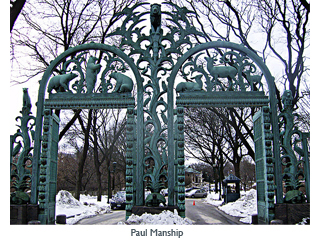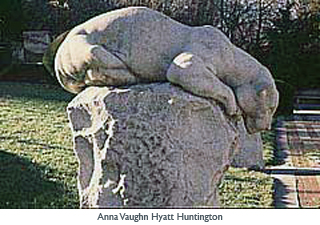Wildlife
Conservation Society
Bronx Zoo185th Street and
|
|
Plans for a zoo in the Bronx were discussed and developed as early as the late 19th Century, at meetings of the Boone and Crockett Club, with Theodore Roosevelt among its members. Established to preserve American wildlife, the club was instrumental in the incorporation of the New York Zoological Park in 1895. Only two years later William Temple Hornaday was hired as the Zoo's first director. Hornaday, the most experienced "zoo man" in the United States, had already helped organize the National Zoological Park in Washington, D.C. He was committed to establishing the Bronx Zoo as one of the foremost in the world and believed that the design and decoration of its buildings and grounds should reflect this ambition.
In 1897 the New York firm of Heins and La Farge was appointed as the official architects. C. Grant La Farge, son of the painter John La Farge, had been one of the founding members of the New York Zoological Society. He and his partner George Lewis Heins had been in partnership since 1880 and were at the time at work on the design for the Cathedral of St. John the Divine in upper Manhattan. The Bronx Zoo opened November 8, 1899.
The architects' first efforts for the Zoological Society were the layout and design of Baird Court, known today as Astor Court, a large ceremonial space that extends from the Pelham Parkway entrance to the Elephant House. Located between the entry gates to the zoo and Astor Court, is the Rockefeller Fountain crafted by Biagio Catella, circa 1872, and named for William Rockefeller who gave it to the Zoological Society in 1910. It was proclaimed a New York City landmark in 1968. With its terraces, formal landscape elements, and symmetrical layout, Baird Court was modeled after the'city beautiful' concept first introduced in the United States at the 1893 World's Colombian Exposition in Chicago. The Reptile House, which opened on the same day as the Zoo in 1899, is the only building of those erected before 1899 that is still in use today, although only the facade remains of the original structure.
The best known sculpture is not on Astor Court but at the Pelham Parkway entrance, where the Paul J. Rainey Memorial Gateway designed in 1926 by the well-known sculptor Paul Manship was installed in 1934. Made of bronze that over the years has turned a light sea green, the gates are a fantastic structure with two openings surmounted by openwork lunettes and bounded by tree like forms. Around the whole, some 22 different animals, including some former Zoo celebrities—Buster the giant Galapagos tortoise, Jimmy the Shoe bill stork, and Sultan the African lion—are used as decorative motifs.
Soon after the Zoo was incorporated, the artist and writer Ernest Seton Thompson petitioned for studio space on behalf of American animaliers or sculptors who specialized in carving or modeling animals. A 21 x 26 foot room with a large screened cage for the models was set aside for sculptors and opened during the summer of 1903. So successful was this enterprise that several of the animaliers were later awarded commissions for the decoration of many of the animal houses on Baird Court, including the Aquatic Bird House (animal frieze by Alexander Phimister Proctor, no longer extant), the Elephant House now known as the Zoo Center (1907, south side by Proctor and north side by Charles Knight), the Lion House (1903, the sentinel lions by Eli Harvey, other figures by Proctor, the Main Bird House (Proctor), the Primate or Monkey House (1901, animal frieze and pedimental sculpture by Proctor), the Reptile House (animal frieze by Proctor), and the Zebra House (1911, Knight). Anna Vaughn Hyatt Huntington's Jaguars sculptures were donated to the Zoo in 1937. Huntington began preliminary work on the sculptures prior to 1915, using the jaguar who was at the zoo (from 1902 to 1914 when it died) as the model for the sculptures. In addition to being appropriate decorative motifs for zoo buildings, these animal carvings, found in the pediments, friezes, column capitals, and roof cornices, replaced the geometric or floral details that traditionally embellished classically inspired buildings.
[More about the artists]
[More about the Bronx Park neighborhood]
In 1897 the New York firm of Heins and La Farge was appointed as the official architects. C. Grant La Farge, son of the painter John La Farge, had been one of the founding members of the New York Zoological Society. He and his partner George Lewis Heins had been in partnership since 1880 and were at the time at work on the design for the Cathedral of St. John the Divine in upper Manhattan. The Bronx Zoo opened November 8, 1899.
The architects' first efforts for the Zoological Society were the layout and design of Baird Court, known today as Astor Court, a large ceremonial space that extends from the Pelham Parkway entrance to the Elephant House. Located between the entry gates to the zoo and Astor Court, is the Rockefeller Fountain crafted by Biagio Catella, circa 1872, and named for William Rockefeller who gave it to the Zoological Society in 1910. It was proclaimed a New York City landmark in 1968. With its terraces, formal landscape elements, and symmetrical layout, Baird Court was modeled after the'city beautiful' concept first introduced in the United States at the 1893 World's Colombian Exposition in Chicago. The Reptile House, which opened on the same day as the Zoo in 1899, is the only building of those erected before 1899 that is still in use today, although only the facade remains of the original structure.
The best known sculpture is not on Astor Court but at the Pelham Parkway entrance, where the Paul J. Rainey Memorial Gateway designed in 1926 by the well-known sculptor Paul Manship was installed in 1934. Made of bronze that over the years has turned a light sea green, the gates are a fantastic structure with two openings surmounted by openwork lunettes and bounded by tree like forms. Around the whole, some 22 different animals, including some former Zoo celebrities—Buster the giant Galapagos tortoise, Jimmy the Shoe bill stork, and Sultan the African lion—are used as decorative motifs.
Soon after the Zoo was incorporated, the artist and writer Ernest Seton Thompson petitioned for studio space on behalf of American animaliers or sculptors who specialized in carving or modeling animals. A 21 x 26 foot room with a large screened cage for the models was set aside for sculptors and opened during the summer of 1903. So successful was this enterprise that several of the animaliers were later awarded commissions for the decoration of many of the animal houses on Baird Court, including the Aquatic Bird House (animal frieze by Alexander Phimister Proctor, no longer extant), the Elephant House now known as the Zoo Center (1907, south side by Proctor and north side by Charles Knight), the Lion House (1903, the sentinel lions by Eli Harvey, other figures by Proctor, the Main Bird House (Proctor), the Primate or Monkey House (1901, animal frieze and pedimental sculpture by Proctor), the Reptile House (animal frieze by Proctor), and the Zebra House (1911, Knight). Anna Vaughn Hyatt Huntington's Jaguars sculptures were donated to the Zoo in 1937. Huntington began preliminary work on the sculptures prior to 1915, using the jaguar who was at the zoo (from 1902 to 1914 when it died) as the model for the sculptures. In addition to being appropriate decorative motifs for zoo buildings, these animal carvings, found in the pediments, friezes, column capitals, and roof cornices, replaced the geometric or floral details that traditionally embellished classically inspired buildings.
[More about the artists]
[More about the Bronx Park neighborhood]
Photographs:
Lehman College Art Gallery and Julian A. Henderson


